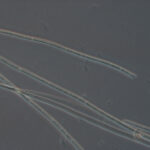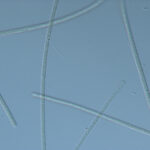Detected Species
-
HAB Species
- Diatoms
- Dinoflagellates
- Cyanobacteria
- Raphidophytes
- Haptophytes
-
Non-toxic Species
- Diatoms
- Dinoflagellates
Contact Us:
Mihaela D. Enache, Ph.D., Project Manager & Co-PI, Research Scientist I, Division of Science and Research, NJDEP (mihaela.enache@dep.nj.gov)
Ling Ren, Ph.D., PI, Research Assistant Professor, College of Science, George Mason University (lren2@gmu.edu)
Planktothrix agardhii
Morphology
Trichomes unbranched, straight, ends of trichomes can be blunt or pointed; Cells usually longer than wide, width 4–6 μm; blue-green in color.
Toxins and toxicity
Microcystins, anatoxins. Study revealed salt acclimation of P. agardhii in producing microcystins (Vergalli et al., 2020).
Distribution and Occurrence
Fresh to brackish waters; a resilient and persistent species known to tolerate a wide range of temperatures and light intensities. In this study, this species was detected in salt marsh ponds in REF-1, REF-2, PGD-2, OMWM-1in winter, and OMWM-2 in November, January, April, and June.
References
Hallegraeff, G. M., D. M. Anderson, A. D. Cembella, and H. O. Enevoldsen. 2004. Manual on harmful marine microalgae, 2nd rev. ed. UNESCO.
Vergalli, J., S. Fayolle, A. Combès, E. Franquet, K. Comte. 2020. Persistence of microcystin production by Planktothrix agardhii (Cyanobacteria) exposed to different salinities. Phycologia, 59 (1), pp.24-34. 10.1080/00318884.2019.1664875
Churro, C., J. Azevedo, V. Vasconcelos, and A. Silva. 2017. Detection of a Planktothrix agardhii Bloom in Portuguese Marine Coastal Waters. Toxins 9: 391. doi:10.3390/toxins9120391


